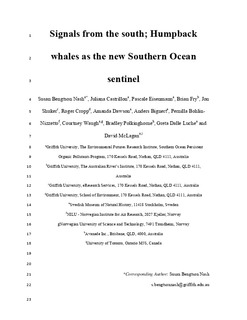Signals from the south; humpback whales carry messages of Antarctic sea‐ice ecosystem variability
| dc.contributor.author | Nash, Susan M. Bengtson | |
| dc.contributor.author | Castrillon, Juliana | |
| dc.contributor.author | Eisenmann, Pascale | |
| dc.contributor.author | Fry, Brian | |
| dc.contributor.author | Shuker, Jon D. | |
| dc.contributor.author | Cropp, Roger A. | |
| dc.contributor.author | Dawson, Amanda | |
| dc.contributor.author | Bignert, Anders | |
| dc.contributor.author | Bohlin-Nizzetto, Pernilla | |
| dc.contributor.author | Waugh, Courtney | |
| dc.contributor.author | Polkinghorne, Bradley J. | |
| dc.contributor.author | Luche, Greta Dalle | |
| dc.contributor.author | McLagan, David | |
| dc.date.accessioned | 2019-06-06T13:17:13Z | |
| dc.date.available | 2019-06-06T13:17:13Z | |
| dc.date.created | 2018-04-05T10:08:14Z | |
| dc.date.issued | 2018 | |
| dc.identifier.citation | Global Change Biology. 2018, 24 (4), 1500-1510. | nb_NO |
| dc.identifier.issn | 1354-1013 | |
| dc.identifier.uri | http://hdl.handle.net/11250/2600197 | |
| dc.description.abstract | Southern hemisphere humpback whales (Megaptera novaeangliae) rely on summer prey abundance of Antarctic krill (Euphausia superba) to fuel one of the longest‐known mammalian migrations on the planet. It is hypothesized that this species, already adapted to endure metabolic extremes, will be one of the first Antarctic consumers to show measurable physiological change in response to fluctuating prey availability in a changing climate; and as such, a powerful sentinel candidate for the Antarctic sea‐ice ecosystem. Here, we targeted the sentinel parameters of humpback whale adiposity and diet, using novel, as well as established, chemical and biochemical markers, and assembled a time trend spanning 8 years. We show the synchronous, inter‐annual oscillation of two measures of humpback whale adiposity with Southern Ocean environmental variables and climate indices. Furthermore, bulk stable isotope signatures provide clear indication of dietary compensation strategies, or a lower trophic level isotopic change, following years indicated as leaner years for the whales. The observed synchronicity of humpback whale adiposity and dietary markers, with climate patterns in the Southern Ocean, lends strength to the role of humpback whales as powerful Antarctic sea‐ice ecosystem sentinels. The work carries significant potential to reform current ecosystem surveillance in the Antarctic region. | nb_NO |
| dc.language.iso | eng | nb_NO |
| dc.publisher | Wiley | nb_NO |
| dc.title | Signals from the south; humpback whales carry messages of Antarctic sea‐ice ecosystem variability | nb_NO |
| dc.type | Journal article | nb_NO |
| dc.type | Peer reviewed | nb_NO |
| dc.description.version | acceptedVersion | nb_NO |
| dc.source.pagenumber | 1500-1510 | nb_NO |
| dc.source.volume | 24 | nb_NO |
| dc.source.journal | Global Change Biology | nb_NO |
| dc.source.issue | 4 | nb_NO |
| dc.identifier.doi | 10.1111/gcb.14035 | |
| dc.identifier.cristin | 1577625 | |
| dc.description.localcode | This is the peer reviewed version of an article, which has been published in final form at [http://dx.doi.org/10.1111/gcb.14035]. This article may be used for non-commercial purposes in accordance with Wiley Terms and Conditions for Self-Archiving. | nb_NO |
| cristin.unitcode | 194,66,10,0 | |
| cristin.unitname | Institutt for biologi | |
| cristin.ispublished | true | |
| cristin.fulltext | original | |
| cristin.qualitycode | 2 |
Tilhørende fil(er)
Denne innførselen finnes i følgende samling(er)
-
Institutt for biologi [2573]
-
Publikasjoner fra CRIStin - NTNU [38070]
